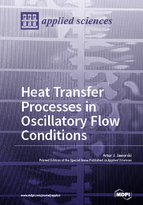Heat Transfer Processes in Oscillatory Flow Conditions
A special issue of Applied Sciences (ISSN 2076-3417). This special issue belongs to the section "Energy Science and Technology".
Deadline for manuscript submissions: closed (31 May 2017) | Viewed by 56276
Special Issue Editor
Interests: energy; heat transfer; thermodynamics; thermoacoustics; fluids; aerodynamics; multiphase flow; process tomography; sensors and instrumentation; heterogeneous mixtures; microfluidics; nanofluids
Special Issue Information
Dear Colleagues,
I would like to extend a warm invitation to all colleagues who would like to submit their research papers to the Special Issue of Applied Sciences (ISSN 2076-3417; CODEN: ASPCC7) on "Heat Transfer Processes in Oscillatory Flow Conditions". Heat exchange processes in steady flows have been studied extensively over the last two hundred years, and are now part of undergraduate syllabi of most engineering courses. However, heat transfer processes in oscillatory flow conditions are still not very well understood. Their importance is well recognized in applications, including Stirling machines, thermoacoustic devices or pulsed-tube coolers in cryogenics. Additionally, enhancement of heat transfer by using oscillatory, and, in some cases, pulsating flows is important in many areas of mechanical and chemical engineering for intensification of heat transfer processes and possible miniaturization of heat exchangers of the future. This Special Issue will give an opportunity of consolidating the recent advances in this important research field. All types of research approaches are equally acceptable: Experimental, theoretical, CFD, and their mixtures; the papers can be both of a fundamental and/or applied nature; the heat transfer phenomena can be looked at from either global/macroscopic perspective (e.g., whole heat exchanger units working in oscillatory flow regime) or local/microscopic perspective (e.g., fundamentals of heat transfer in individual channels where such processes occur in oscillatory flow regime). Contributions are also invited from all disciplines, including, but not limited to, engineering, physics and chemistry, and biological and medical sciences – the underlying theme being heat transfer processes in oscillatory flow conditions.
Prof. Artur J. Jaworski
Guest Editor
Manuscript Submission Information
Manuscripts should be submitted online at www.mdpi.com by registering and logging in to this website. Once you are registered, click here to go to the submission form. Manuscripts can be submitted until the deadline. All submissions that pass pre-check are peer-reviewed. Accepted papers will be published continuously in the journal (as soon as accepted) and will be listed together on the special issue website. Research articles, review articles as well as short communications are invited. For planned papers, a title and short abstract (about 100 words) can be sent to the Editorial Office for announcement on this website.
Submitted manuscripts should not have been published previously, nor be under consideration for publication elsewhere (except conference proceedings papers). All manuscripts are thoroughly refereed through a single-blind peer-review process. A guide for authors and other relevant information for submission of manuscripts is available on the Instructions for Authors page. Applied Sciences is an international peer-reviewed open access semimonthly journal published by MDPI.
Please visit the Instructions for Authors page before submitting a manuscript. The Article Processing Charge (APC) for publication in this open access journal is 2400 CHF (Swiss Francs). Submitted papers should be well formatted and use good English. Authors may use MDPI's English editing service prior to publication or during author revisions.
Keywords
- Oscillatory flow
- oscillatory heat transfer
- heat exchanger design
- complex transport coefficients,
- experimental, theoretical, numerical, fundamentals & applications






